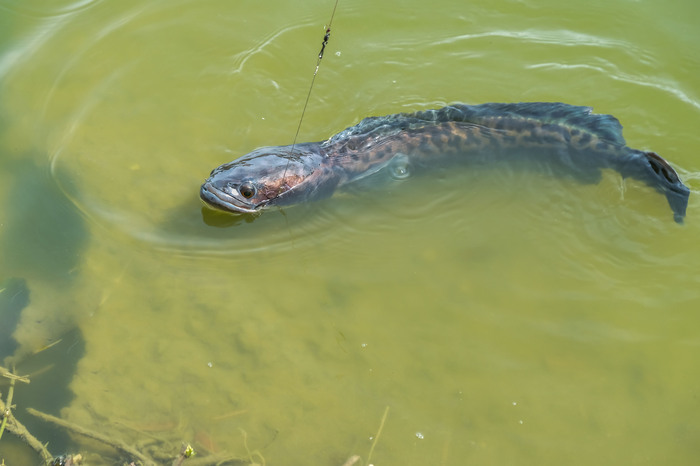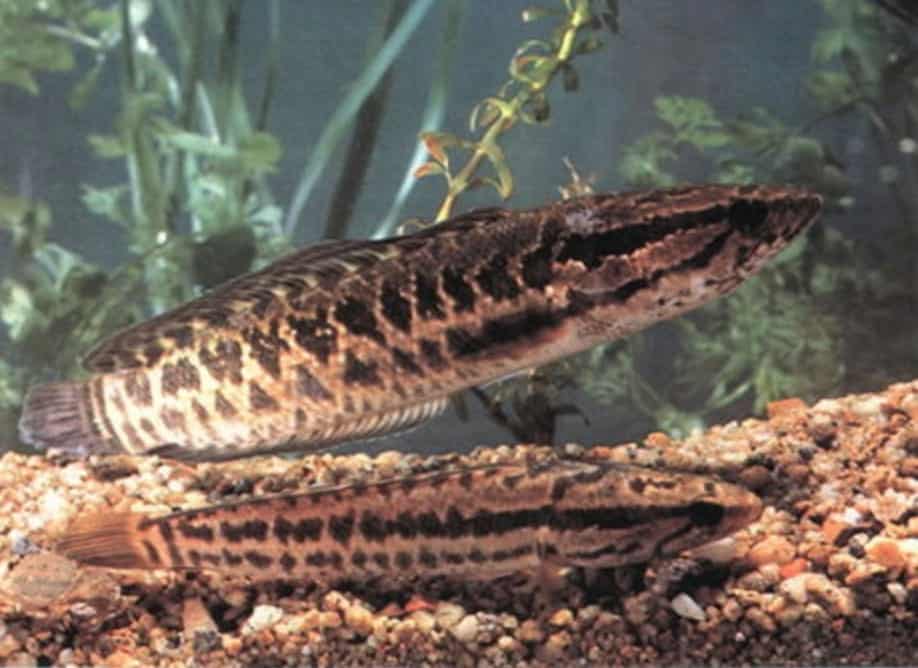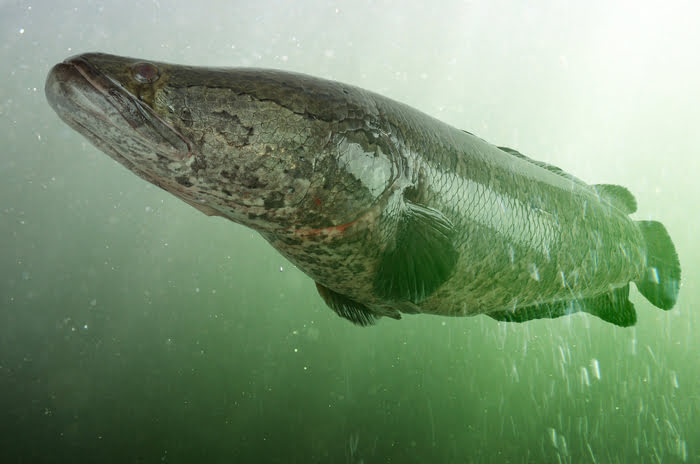They’re mean, green, killing machines, and they’ve taken over various parts of the US by storm due to human influence.
Snakeheads are one of the weirdest fish families available to American anglers, and they happen to fight hard and taste delicious too!
So spool up some braided line and sharpen your hooks, because we’re slithering into the story of where these aliens came from, where to find them, and how to catch them.
Table of Contents
A Beast From the East
Native to tropical locations in Asia and Africa, the snakehead family (channidae) has become established in the US after escaping from fish farms.
Quickly taking the nation by storm, they can currently be found in the Mid-Atlantic region, Florida, and Hawaii, and their range is still growing.
These ambush predators can be caught with most bass fishing techniques, but can grow much larger and will fight like a freight train.
It’s suggested (and required by law in some states) that you kill any snakehead that you land in the states to help stop their spread.
This is also perfect for your inner chef, because their flesh is known to taste wonderful. After all, they were originally brought here for food!

How’d They Get Here?
Snakeheads have long been caught and farmed for food in their native Asian range, and as Asian immigrants came to America they brought a taste for this fish with them.
To meet this demand, Asian food importers brought these fish over to the states to farm and sell them.
Tragedy struck when large storms caused the farm pools to flood their banks, allowing the snakeheads to escape into American waterways.
This is where they started eating anything and everything in sight, quickly establishing themselves as apex predators in the habitats they invaded!
Why Are Snakehead Fish A Problem?
Snakeheads have been known to damage American ecosystems and disrupt the natural food chain by outcompeting native predators like bass and bowfin.
The only American animal known to prey on young snakeheads are wading birds such as herons.
Snakeheads can breathe air through their mouth, allowing them to survive in stagnant, low-oxygen waters.
They can even slide across land for short distances, allowing them to migrate between bodies of water. These traits make them the ideal invaders!
Snakeheads are often confused with the bowfin, which is a native fish. These swamp dwellers look very similar since they fill a similar ecological niche to snakeheads. Unlike these invaders, bowfin are an important resident of American waters!
The easiest way to tell bowfin from snakehead is to look at the anal fin on the bottom of the fish. Snakeheads will have a long, continuous anal fin to match their long dorsal fin. Bowfin have a long dorsal fin, but their anal fin is much smaller.
Bowfin should be released if they’re caught, not only because they are important native fish but also because they don’t taste nearly as good as snakeheads do. Save your filleting skills for the snakeheads!
Types Of Snakehead Fish
Three species of snakehead have made this transcontinental jump, which we will cover in more detail below.
The Northern Snakehead
Native to northern China, Southern Russia, and Korea, the northern snakehead (Channa argus) is the only species in the whole family that can tolerate temperate climates with colder winters.
This makes it particularly threatening to America’s temperate fisheries, which other snakeheads couldn’t survive in. Its disruptive presence in a larger portion of prime freshwater fishing grounds has made it the most well-known of the US snakeheads!
The first report of a northern snakehead caught in the US came in 1997, and they have spread far and wide since then despite active containment efforts.
They can now be found in large numbers in Maryland, Virginia, New Jersey, Delaware, New York, and Pennsylvania where they are established.

The Potomac, Blackwater and Susquehanna rivers are known northern snakehead hotspots, but this fish can be found in other rivers and lakes as well. Like any other fish, exploration will help you find a honey hole!
The northern snakehead can be identified by its dark green or brown coloration broken up by ‘leopard print’ spots on its sides. This fish has evolved to blend into weeds and mud, and it does a great job!
Growing to a maximum size of around 3 feet and weighing over 15 pounds, this dinosaur of a fish is a true menace, but a worthy challenge for anglers!
In recent years, snakeheads have begun to be caught in the Midwest as well. One was caught in Missouri in 2019, with a second being caught in the state just last month!
While the government is hard at work preventing its spread, it seems like the northern snakehead will eventually be coming to a waterway near you.
The Goldline Snakehead
Unlike the northern variety, most species of snakehead can only survive in tropical waters. Unfortunately for Florida, tropical freshwater is a hallmark of the state!
Among the wide variety of invasives currently swimming in Florida’s waters, the goldline snakehead (Channa aurolineata) has become a common sight. Canals, ponds, and other freshwater sources are common places to see them.
Growing just as large and fighting just as ferociously as its northern cousin, the goldline snakehead can be identified by its gold coloration with a series of small ‘eye spots’ running down the length of its body.

These Floridian invaders were long thought to be bullseye snakehead (Channa marulius), but in 2018 it was found that the native Asian population actually consisted of several distinct species!
Upon realizing this, Florida’s snakeheads were genetically analyzed and found to belong to this newly recognized species.
The Blotched Snakehead
The blotched snakehead (Channa maculata) is the smallest American snakehead on our list, but it’s also the oldest!
It’s been living on the island of Oahu, Hawaii since at least the 1870’s (before Hawaii was even part of the US), giving it plenty of time to become established in the island’s fresh waters.
The blotched snakehead looks very similar to the northern snakehead, however the spotting on its sides form a more organized pattern. It is also a much smaller fish overall, rarely growing larger than a foot long.

Similar to the goldline snakehead, the Hawaiian population was thought to be striped snakehead (Channa striata) for over a century- this mistake was only recognized and corrected in 2002!
As they have been in their new habitat for the longest, they are considered an established part of Oahu’s freshwater ecosystems and are unlikely to do any more damage by remaining.
How to Catch Snakeheads
All three species of invasive snakehead are ambush predators, meaning that they will sit perfectly still and wait for prey to pass close by, not noticing their presence. This is when they strike in a quick lunge, gulping down their food- or your bait!
For this reason, snakeheads prefer to live in slow-moving or stagnant water with plenty of cover. Lily pads, floating algae, and underwater vegetation and structure all provide ideal snakehead hiding spots.
You may be able to see their huge, ominous silhouettes as they glide beneath the surface, and can sometimes hear a little gulping sound as they some up to grab some air to breathe.

Just like bass, you can also see and hear huge splashes when they ‘blow up’ on topwater prey!
Overall, these fish live in many of the same places that largemouth bass love to lurk in the summertime, with the exception that they won’t move into faster flowing creeks like bass do.
Lures For Snakehead Fishing
Topwater baits like frogs are particularly effective for catching snakeheads since they often hide beneath floating vegetation that will cause you to snag when fishing beneath the surface.
Slowly popping a frog across lily pads or algae will often tempt a hungry snake to go on the attack!
Other hardbody topwater baits can work well too, like a whopper plopper or zara-spook.
But I’ve had great luck with a simple weedless fluke; these lures land very softly in the water and you can often drag it right over the nose of a snakehead and trigger a very strong reaction bite.
However you get that bite, it’s important to set the hook harder than you would for other fish.
Snakeheads have extremely hard and bony mouths that are hard to penetrate, and a soft set can result in you pulling the bait right out of its mouth. When you’re sure the bait is in, give it a good yank and hold on tight!
Fishing for snakeheads is also similar to fishing for lunker largemouth! Many of the same baits will work, including senko worms, crankbaits, large spinners, live minnows, and the classic worm and bobber. Try a few and see what works!
Snakehead Fishing Tips
These fish are called ‘dragons’ for more than just looks- hook into a fully grown snakehead and you’ll feel like a medieval knight!
These fish are known to fight with every ounce of their huge bodies and will often pull you through line-catching weeds.
Braided line is a must as well. Snakeheads have sharp teeth lining their lips that can easily break you off if you’re using monofilament line!
I use at least 30 pound braid whenever I want to catch snakeheads, and some people go heavier as well.
It’s a hard fight, but it will be well worth the trouble when you’re holding that behemoth up on land! Snakehead tournaments are often hosted in the areas where this fish lives due to this fish’s incredible fight and size.
How do Snakeheads Taste?
As mentioned earlier, snakeheads were originally brought to the states because of their tasty flesh, and that hasn’t changed since they got loose!
They’re described as having a mild flavor with flesh that’s not too firm but not too soft either.
Eating them is sustainable, too! By killing these fish when caught, anglers help to prevent their spread, protecting native species.
Many restaurants sell snakehead dishes in the regions where they can be found, and they are often cheaper than other fish on the menu.
Snakeheads can be cooked in a variety of ways, including frying, broiling, baking, and more! Fish sandwiches, fish tacos, fish and chips, and fish cakes have all been tried, and apparently all taste delicious!
Many recipes are available online, but always feel free to experiment and find whatever makes your mouth water.
Conclusion
While snakeheads aren’t meant to be in the US, anglers from all over are encouraged to enjoy them while they’re here! They’re great for trophy fisherman, aspiring chefs, and anyone looking for something a little different.
So grab some braid and your favorite topwater lure, get out there and go on the hunt; it’s time to slay some dragons!
If you haven’t guessed yet, I love fishing and everything about it!
To learn more about why I started Panfish Nation, visit the About page and follow along on Social Media:


Download a copy of my FREE Lure Color Selection Chart & Knot Guide!
Stay up to date with fishing reports, tackle reviews, industry news, and much more! We respect your privacy, unsubscribe at any time.
